Novel Hybrid Optimization Techniques to Enhance Reliability from Reverse Osmosis Desalination Process
Abstract
1. Introduction
- The optimum sizing of the hybrid solar and wind energy with storage and ROD is constructed using the proposed HCRS algorithm.
- The system’s reliability is estimated by using the loss of power supply probability (LPSP) factor along with the estimation of life cycle cost (LCC). The LCC is used to estimate the environmental impacts of the system. Even though solar based has less impact than fossil fuel, it is necessary to estimate the impact.
- Moreover, the continuous and integer decision variables are considered to describe the power required for RO desalination.
- Finally, the proposed approach can be used to analyze these parameters and optimize the results.
- Further, our proposed method mitigates the maintenance and repair cost using the least resources.
- The utilization of energy required for the conversion process is reduced with our proposed approach.
2. Literature Survey
3. Materials and Methods
- ➢
- Charge state for the Battery (BAT) system
- ➢
- The economic model of Reverse Osmosis Desalination (ROD)
- ➢
- Objective function and limitations
- ➢
- HCRS algorithm for the Hybrid system
- Hybrid CRS algorithm:
3.1. Capuchin Search Algorithm
3.2. Rat Swarm Optimizer (RSO) Algorithm
- (i).
- Prey chasing:
- (ii).
- Fighting with prey:
3.3. Hybrid CRS Algorithm
- Initialize the capuchin search algorithm parameters with the maximum number of iterations.
- Capuchins’ movement from one tree to another resembles projectile motion.
- Update the acceleration and velocity.
- Rat’s trying to chase actions are based on their agonistic nature and on searching for prey upon learning its location.
- The process of selecting a location and upgrading is comparable to how rats compete for their prey.
- After calculating the ideal solution, update the search agent locations.
4. Results and Experimental Outcomes
- Total life cycle cost (TLCC)
- CPU time
5. Conclusions
Author Contributions
Funding
Data Availability Statement
Conflicts of Interest
References
- Hlalele, T.G.; Naidoo, R.M.; Zhang, J.; Bansal, R.C. Dynamic Economic Dispatch With Maximal Renewable Penetration Under Renewable Obligation. IEEE Access 2020, 8, 38794–38808. [Google Scholar] [CrossRef]
- Alam, S.; Al-Ismail, F.S.; Salem, A.; Abido, M.A. High-Level Penetration of Renewable Energy Sources Into Grid Utility: Challenges and Solutions. IEEE Access 2020, 8, 190277–190299. [Google Scholar] [CrossRef]
- Rehman, W.U.; Bhatti, A.R.; Awan, A.B.; Sajjad, I.A.; Khan, A.A.; Bo, R.; Haroon, S.S.; Amin, S.; Tlili, I.; Oboreh-Snapps, O. The Penetration of Renewable and Sustainable Energy in Asia: A State-of-the-Art Review on Net-Metering. IEEE Access 2020, 8, 170364–170388. [Google Scholar] [CrossRef]
- Schefer, H.; Fauth, L.; Kopp, T.H.; Mallwitz, R.; Friebe, J.; Kurrat, M. Discussion on Electric Power Supply Systems for All Electric Aircraft. IEEE Access 2020, 8, 84188–84216. [Google Scholar] [CrossRef]
- Yu, S.S.; Guo, J.; Chau, T.K.; Fernando, T.L.; Iu, H.H.-C.; Trinh, H. An Unscented Particle Filtering Approach to Decentralized Dynamic State Estimation for DFIG Wind Turbines in Multi-Area Power Systems. IEEE Trans. Power Syst. 2020, 35, 2670–2682. [Google Scholar] [CrossRef]
- Atif, A.; Khalid, M. Saviztky–Golay Filtering for Solar Power Smoothing and Ramp Rate Reduction Based on Controlled Battery Energy Storage. IEEE Access 2020, 8, 33806–33817. [Google Scholar] [CrossRef]
- Irfan, M.; Zhao, Z.-Y.; Panjwani, M.K.; Mangi, F.H.; Li, H.; Jan, A.; Ahmad, M.; Rehman, A. Assessing the energy dynamics of Pakistan: Prospects of biomass energy. Energy Rep. 2019, 6, 80–93. [Google Scholar] [CrossRef]
- Yu, L.; Sun, Y.; Xu, Z.; Shen, C.; Yue, D.; Jiang, T.; Guan, X. Multi-Agent Deep Reinforcement Learning for HVAC Control in Commercial Buildings. IEEE Trans. Smart Grid 2020, 12, 407–419. [Google Scholar] [CrossRef]
- Chawda, G.S.; Shaik, A.G.; Mahela, O.P.; Padmanaban, S.; Holm-Nielsen, J.B. Comprehensive Review of Distributed FACTS Control Algorithms for Power Quality Enhancement in Utility Grid With Renewable Energy Penetration. IEEE Access 2020, 8, 107614–107634. [Google Scholar] [CrossRef]
- Mostafa, M.; Abdullah, H.M.; Mohamed, M.A. Modeling and Experimental Investigation of Solar Stills for Enhancing Water Desalination Process. IEEE Access 2020, 8, 219457–219472. [Google Scholar] [CrossRef]
- Oikonomou, K.; Parvania, M. Optimal Coordinated Operation of Interdependent Power and Water Distribution Systems. IEEE Trans. Smart Grid 2020, 11, 4784–4794. [Google Scholar] [CrossRef]
- Subahi, A.F.; Bouazza, K.E. An intelligent IoT-based system design for controlling and monitoring greenhouse temperature. IEEE Access 2020, 8, 125488–125500. [Google Scholar] [CrossRef]
- Mohamed, M.A.; Almalaq, A.; Awwad, E.M.; El-Meligy, M.A.; Sharaf, M.; Ali, Z.M. An Effective Energy Management Approach within a Smart Island Considering Water-Energy Hub. IEEE Trans. Ind. Appl. 2020, 1. [Google Scholar] [CrossRef]
- Semshchikov, E.; Negnevitsky, M.; Hamilton, J.M.; Wang, X. Cost-Efficient Strategy for High Renewable Energy Penetration in Isolated Power Systems. IEEE Trans. Power Syst. 2020, 35, 3719–3728. [Google Scholar] [CrossRef]
- Atallah, M.O.; Farahat, M.; Lotfy, M.E.; Senjyu, T. Operation of conventional and unconventional energy sources to drive a reverse osmosis desalination plant in Sinai Peninsula, Egypt. Renew. Energy 2019, 145, 141–152. [Google Scholar] [CrossRef]
- Wang, Q.; Liu, J.; Hu, Y.; Zhang, X. Optimal Operation Strategy of Multi-Energy Complementary Distributed CCHP System and its Application on Commercial Building. IEEE Access 2019, 7, 127839–127849. [Google Scholar] [CrossRef]
- Ouammi, A.; Achour, Y.; Zejli, D.; Dagdougui, H. Supervisory Model Predictive Control for Optimal Energy Management of Networked Smart Greenhouses Integrated Microgrid. IEEE Trans. Autom. Sci. Eng. 2019, 17, 117–128. [Google Scholar] [CrossRef]
- Poudel, B.; Gokaraju, R. Optimal Operation of SMR-RES Hybrid Energy System for Electricity & District Heating. IEEE Trans. Energy Convers. 2021, 36, 3146–3155. [Google Scholar]
- Baseer, M.A.; Alsaduni, I.; Zubair, M. A Novel Multi-Objective Based Reliability Assessment in Saudi Arabian Power System Arrangement. IEEE Access 2021, 9, 97822–97833. [Google Scholar] [CrossRef]
- Baseer, M.A.; Alsaduni, I.; Zubair, M. Novel Hybrid Optimization Maximum Power Point Tracking and Normalized Intelligent Control Techniques for Smart Grid Linked Solar Photovoltaic System. Energy Technol. 2021, 9, 2000980. [Google Scholar] [CrossRef]
- Zubair, M.; Awan, A.B.; Praveen, R.P.; Baseer, M.A. Solar energy export prospects of the kingdom of saudi arabia. J. Renew. Sustain. Energy 2019, 11, 045902. [Google Scholar] [CrossRef]
- Praveen, R.P.; Abdul Baseer, M.; Awan, A.; Zubair, M. Performance analysis and optimization of a parabolic trough solar power plant in the middle east region. Energies 2018, 11, 741. [Google Scholar] [CrossRef]
- Baseer, M.; Praveen, R.P.; Zubair, M.; Khalil, A.G.A.; Al Saduni, I. Performance and Optimization of Commercial Solar PV and PTC Plants. Int. J. Recent Technol. Eng. 2020, 8, 1703–1714. [Google Scholar] [CrossRef]
- Zubair, M.; Awan, A.B.; Baseer, M.A.; Khan, M.N.; Abbas, G. Optimization of parabolic trough based concentrated solarpower plant for energy export from Saudi Arabia. Energy Rep. 2021, 7, 4540–4554. [Google Scholar] [CrossRef]
- Alhaj, M.; Al-Ghamdi, S.G. Integrating concentrated solar power with seawater desalination technologies: A multi-regional environmental assessment. Environ. Res. Lett. 2019, 14, 074014. [Google Scholar] [CrossRef]
- Alqaed, S.; Mustafa, J.; Almehmadi, F. Design and Energy Requirements of a Photovoltaic-Thermal Powered Water Desalination Plant for the Middle East. Int. J. Environ. Res. Public Health 2021, 18, 1001. [Google Scholar] [CrossRef]
- Ershad, A.M.; Brecha, R.J.; Hallinan, K. Analysis of solar photovoltaic and wind power potential in Afghanistan. Renew. Energy 2016, 85, 445–453. [Google Scholar] [CrossRef]
- Al-Dousari, A.; Al-Nassar, W.; Al-Hemoud, A.; Alsaleh, A.; Ramadan, A.; Al-Dousari, N.; Ahmed, M. Solar and wind energy: Challenges and solutions in desert regions. Energy 2019, 176, 184–194. [Google Scholar] [CrossRef]
- Hlal, M.I.; Ramachandaramurthy, V.K.; Sarhan, A.; Pouryekta, A.; Subramaniam, U. Optimum battery depth of discharge for off-grid solar PV/battery system. J. Energy Storage 2019, 26, 100999. [Google Scholar] [CrossRef]
- Ortiz, X.; Rival, D.; Wood, D. Forces and Moments on Flat Plates of Small Aspect Ratio with Application to PV Wind Loads and Small Wind Turbine Blades. Energies 2015, 8, 2438–2453. [Google Scholar] [CrossRef]
- Magnor, D.; Sauer, D.U. Optimization of PV Battery Systems Using Genetic Algorithms. Energy Procedia 2016, 99, 332–340. [Google Scholar] [CrossRef]
- Krishna, H.J. Introduction to desalination technologies. Tex. Water Dev. 2004, 2, 1–7. [Google Scholar]
- Spiegler, K.; El-Sayed, Y. The energetics of desalination processes. Desalination 2001, 134, 109–128. [Google Scholar] [CrossRef]
- Ramu, S.; Ranganathan, R.; Ramamoorthy, R. Capuchin search algorithm based task scheduling in cloud computing environment. Yanbu J. Eng. Sci. 2022, 19, 18–29. [Google Scholar] [CrossRef]
- Wu, Z.; Chen, T.; Wang, H.; Shi, H.; Li, M. Investigate aerodynamic performance of wind turbine blades with vortex generators at the transition area. Wind Eng. 2022, 46, 615–629. [Google Scholar] [CrossRef]
- Braik, M.; Sheta, A.; Al-Hiary, H. A novel meta-heuristic search algorithm for solving optimization problems: Capuchin search algorithm. Neural Comput. Appl. 2020, 33, 2515–2547. [Google Scholar] [CrossRef]
- Ma, Y.; Zhao, F.; Hao, H.; Liu, Z. Life-Cycle Cost Analysis of Low-Speed Electric Vehicles Using Different Kinds of Battery Technologies Based on Chinese Market. In Proceedings of the International Conference on Applied Energy, Västerås, Sweden, 12–15 August 2019; p. 4. [Google Scholar]
- Dhiman, G.; Garg, M.; Nagar, A.; Kumar, V.; Dehghani, M. A novel algorithm for global optimization: Rat Swarm Optimizer. J. Ambient. Intell. Humaniz. Comput. 2020, 12, 8457–8482. [Google Scholar] [CrossRef]
- Tamilarasan, A.; Renugambal, A.; Vijayan, D. Parametric estimation for AWJ cutting of Ti-6Al-4V alloy using Rat swarm optimization algorithm. Mater. Manuf. Process. 2022, 37, 1871–1881. [Google Scholar] [CrossRef]
- Mirjalili, S.; Lewis, A. The whale optimization algorithm. Adv. Eng. Softw. 2016, 95, 51–67. [Google Scholar] [CrossRef]
- Bansal, J.C. Particle Swarm Optimization. In Evolutionary and Swarm Intelligence Algorithms; Springer: Cham, Switzerland, 2019; pp. 11–23. [Google Scholar]
- Mirjalili, S. Genetic Algorithm. In Evolutionary Algorithms and Neural Networks; Springer: Cham, Switzerland, 2019; pp. 43–55. [Google Scholar]

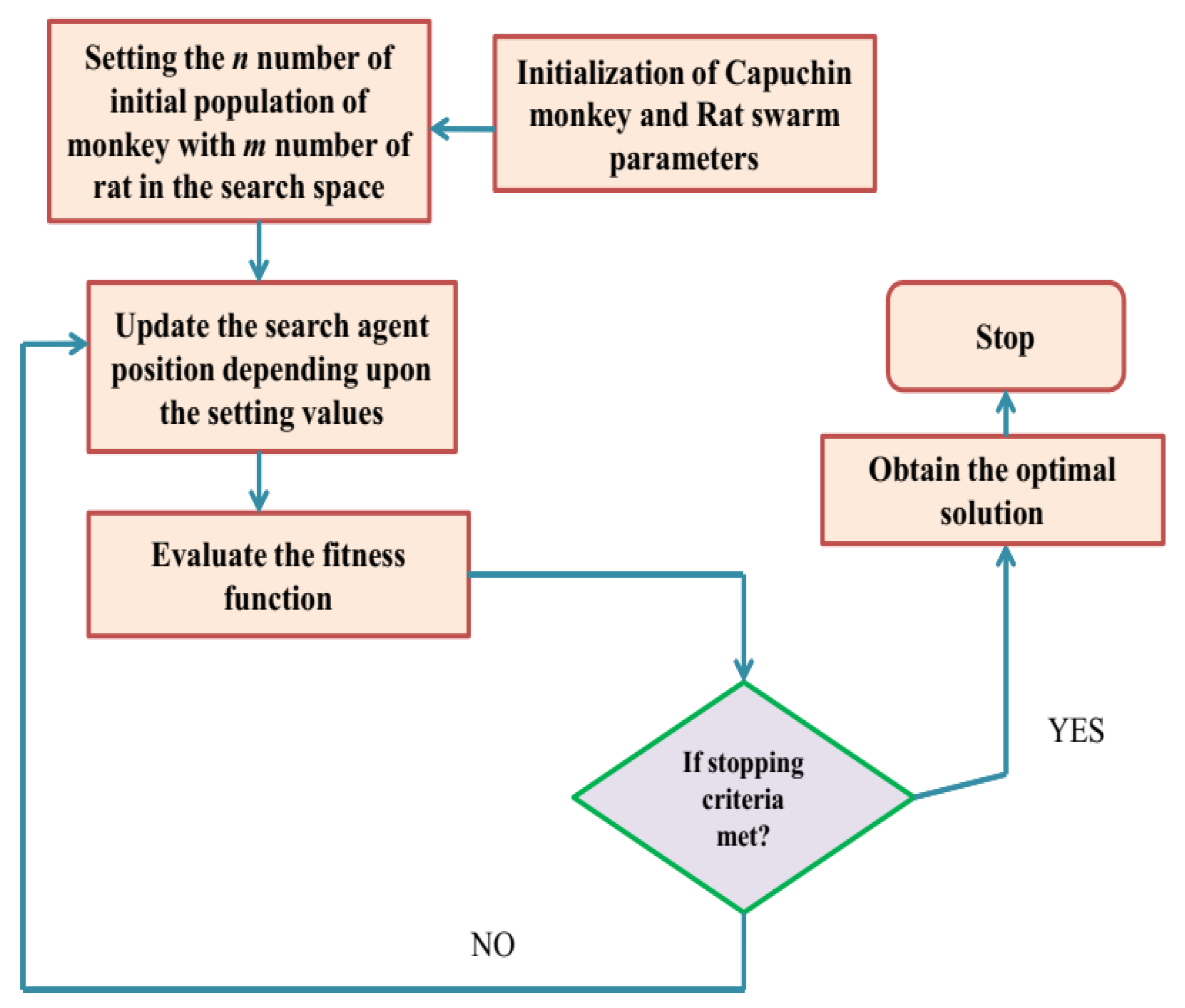
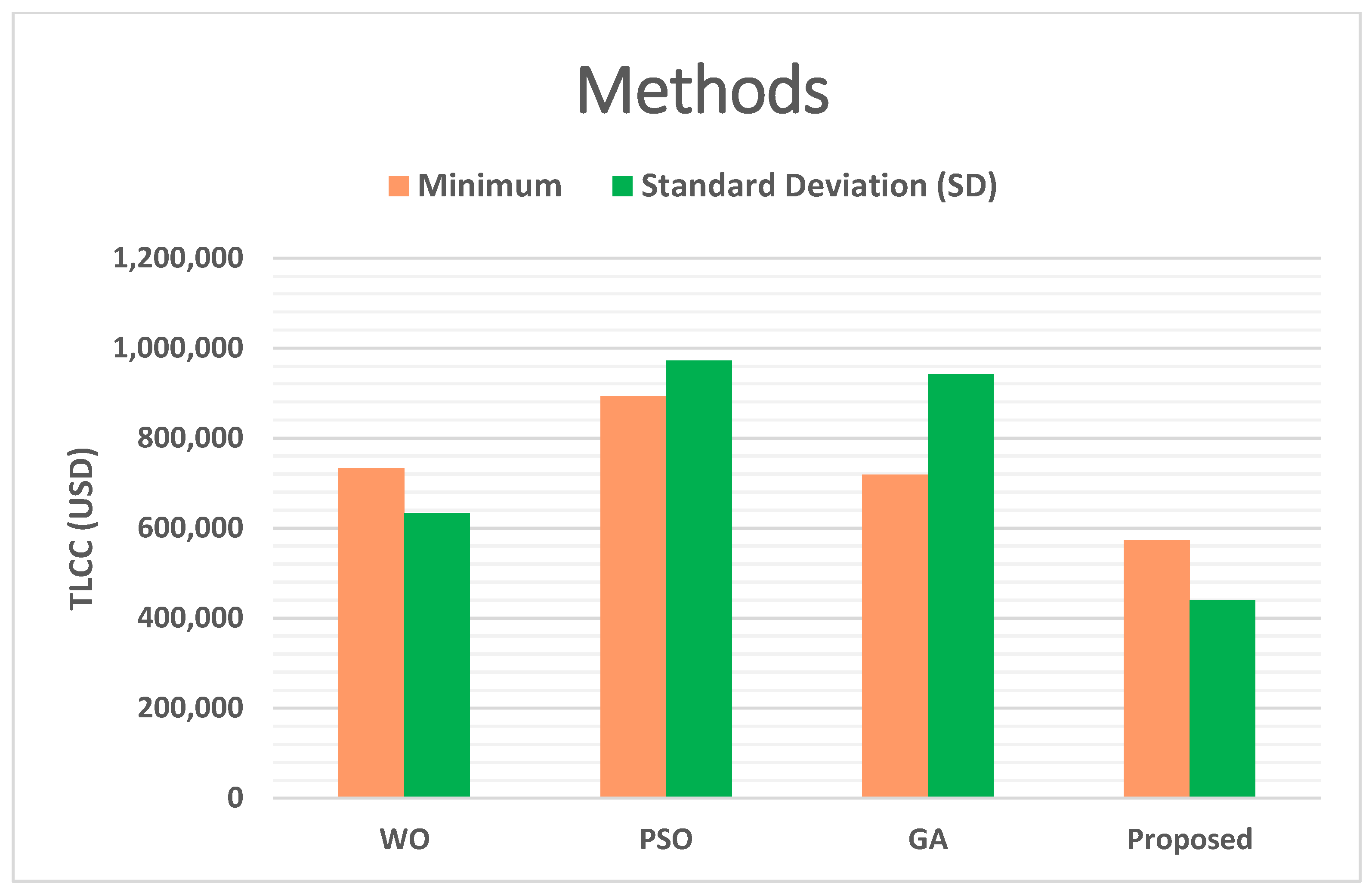

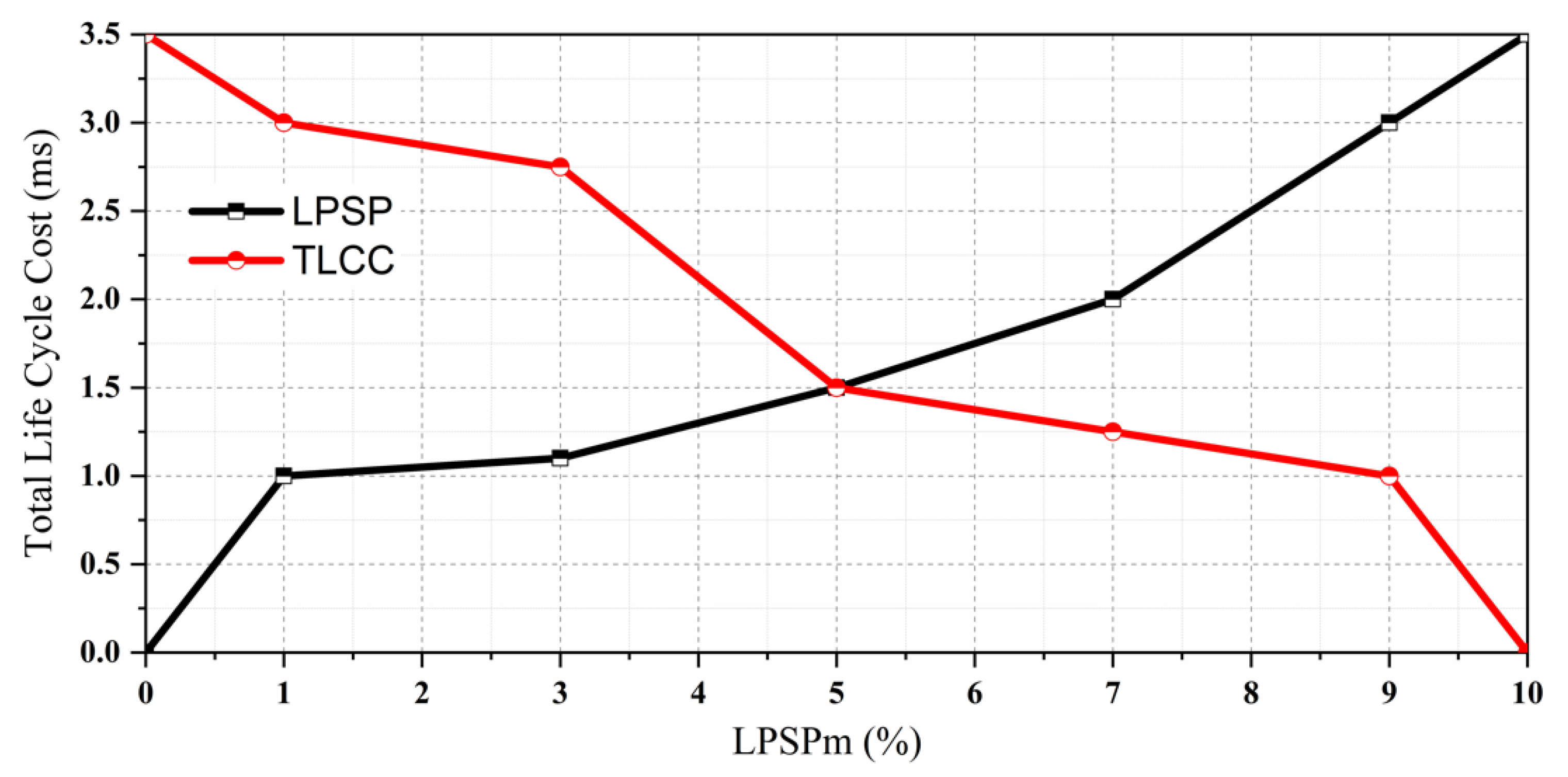
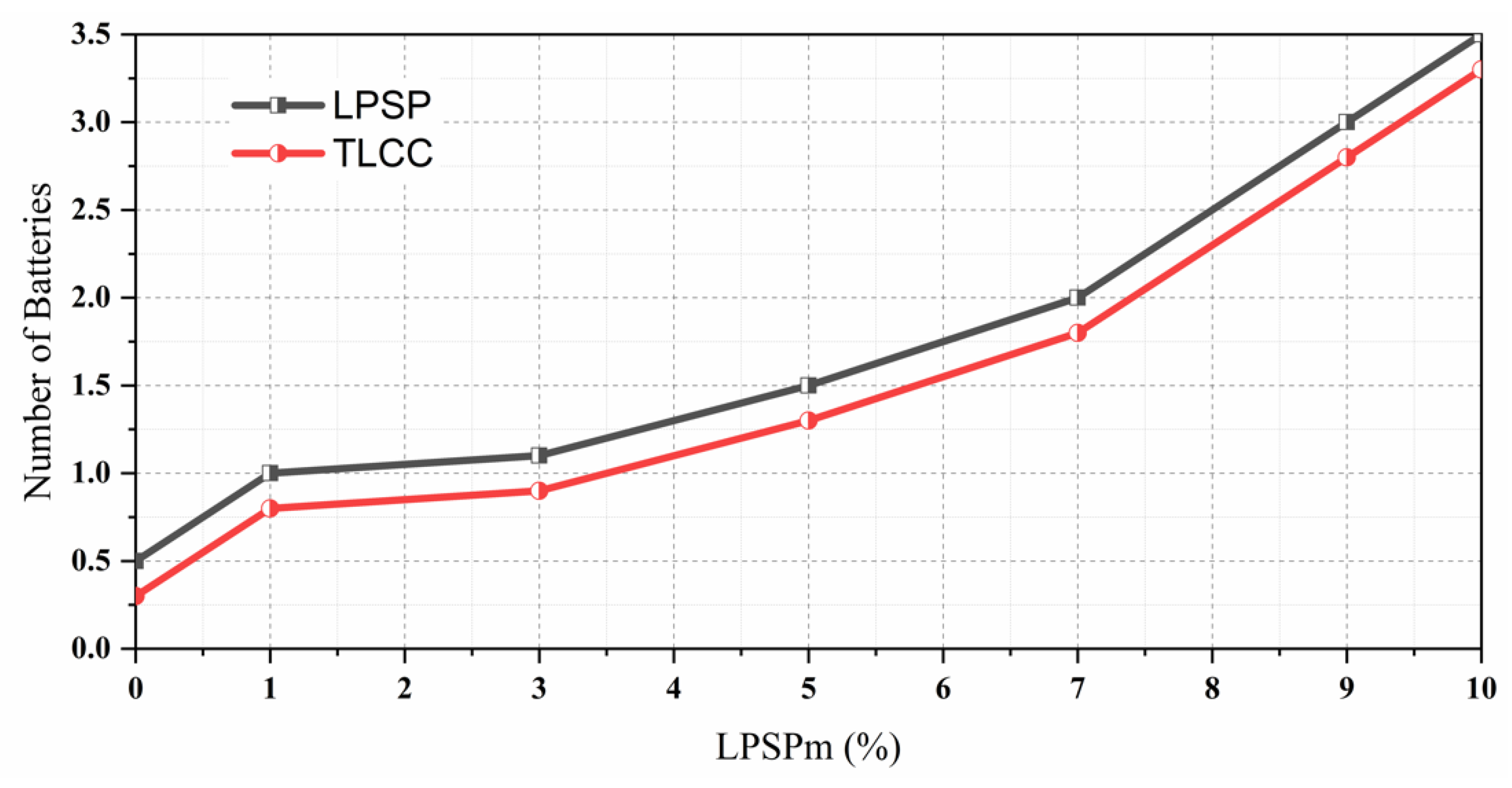
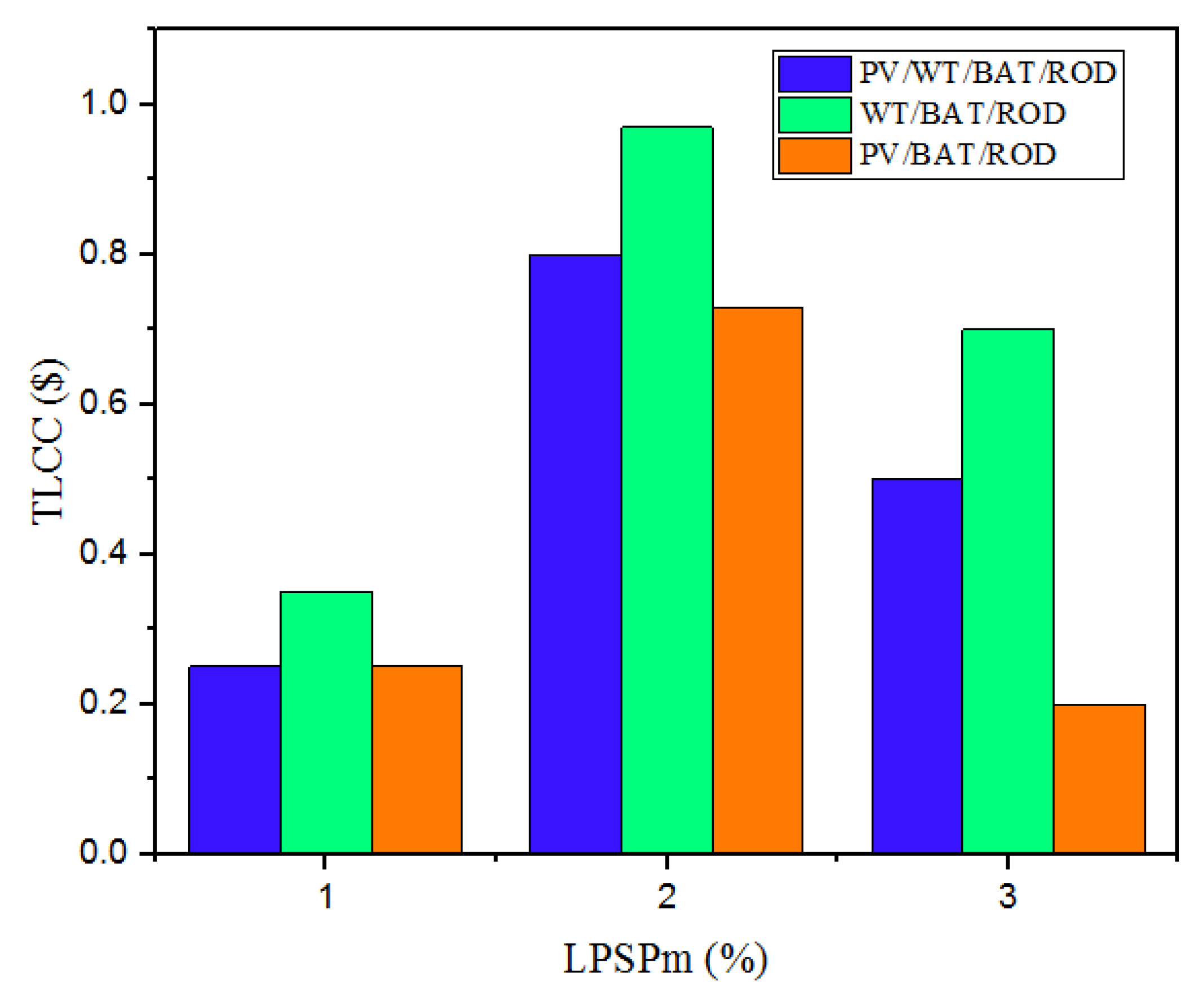
| Methods | Total Life Cycle Cost (USD) | |||
|---|---|---|---|---|
| Minimum | Maximum | Standard Deviation (SD) | Mean | |
| WO | 325,343 | 1,423,423 | 241,881 | 1,231,910 |
| PSO | 302,123 | 1,532,452 | 202,321 | 1,613,808 |
| GA | 337,163 | 1,614,552 | 210,532 | 1,432,723 |
| Proposed | 202,302 | 1,523,134 | 123,454 | 1,213,823 |
| Methods | TLCC (USD) | |
|---|---|---|
| Minimum | Standard Deviation | |
| WO | 1,527,834 | 1,854,372 |
| PSO | 1,423,124 | 1,943,032 |
| GA | 1,232,121 | 1,696,384 |
| Proposed | 1,141,010 | 1,563,900 |
| Methods | TLCC (USD) | |
|---|---|---|
| Minimum | Standard Deviation | |
| WO | 650,804 | 854,372 |
| PSO | 823,184 | 943,032 |
| GA | 446,171 | 106,384 |
| Proposed | 353,210 | 663,900 |
| Methods | CPU Time in Seconds | ||
|---|---|---|---|
| Minimum | Maximum | Mean | |
| WO | 35.45 | 50.12 | 42.34 |
| PSO | 39.32 | 52.67 | 40.26 |
| GA | 37.32 | 48.23 | 45.32 |
| Proposed | 34.21 | 40.23 | 38.10 |
Disclaimer/Publisher’s Note: The statements, opinions and data contained in all publications are solely those of the individual author(s) and contributor(s) and not of MDPI and/or the editor(s). MDPI and/or the editor(s) disclaim responsibility for any injury to people or property resulting from any ideas, methods, instructions or products referred to in the content. |
© 2023 by the authors. Licensee MDPI, Basel, Switzerland. This article is an open access article distributed under the terms and conditions of the Creative Commons Attribution (CC BY) license (https://creativecommons.org/licenses/by/4.0/).
Share and Cite
Baseer, M.A.; Vinoth Kumar, V.; Izonin, I.; Dronyuk, I.; Velmurugan, A.K.; Swapna, B. Novel Hybrid Optimization Techniques to Enhance Reliability from Reverse Osmosis Desalination Process. Energies 2023, 16, 713. https://doi.org/10.3390/en16020713
Baseer MA, Vinoth Kumar V, Izonin I, Dronyuk I, Velmurugan AK, Swapna B. Novel Hybrid Optimization Techniques to Enhance Reliability from Reverse Osmosis Desalination Process. Energies. 2023; 16(2):713. https://doi.org/10.3390/en16020713
Chicago/Turabian StyleBaseer, Mohammad Abdul, Venkatesan Vinoth Kumar, Ivan Izonin, Ivanna Dronyuk, Athyoor Kannan Velmurugan, and Babu Swapna. 2023. "Novel Hybrid Optimization Techniques to Enhance Reliability from Reverse Osmosis Desalination Process" Energies 16, no. 2: 713. https://doi.org/10.3390/en16020713
APA StyleBaseer, M. A., Vinoth Kumar, V., Izonin, I., Dronyuk, I., Velmurugan, A. K., & Swapna, B. (2023). Novel Hybrid Optimization Techniques to Enhance Reliability from Reverse Osmosis Desalination Process. Energies, 16(2), 713. https://doi.org/10.3390/en16020713








